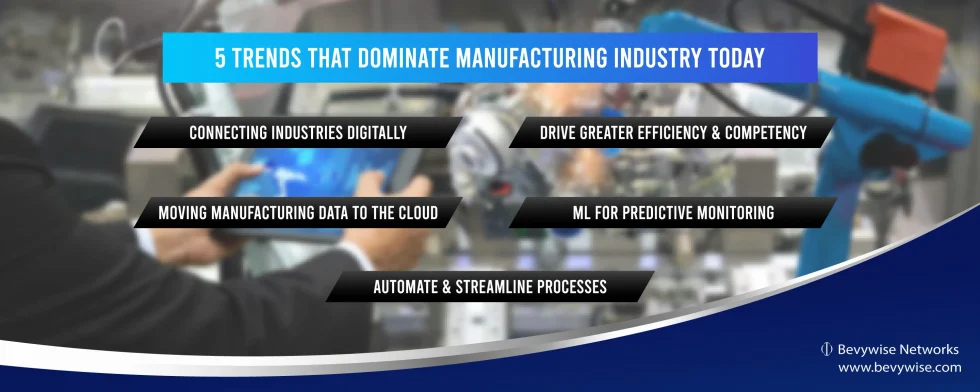5 Trends that Dominate Manufacturing Industry Today
by Saravana Kumar

“The only thing that never changes is change itself ― D.B Coulson”.
Every day something new in technology is rising and it is replacing something good with the best. Likewise, digital perspective is changing the manufacturing industry. As industrial revolution has an effect on manufacturing since decades, now digital transformation is at the helm of changing the manufacturing industry. The transformation of traditional approaches to digital in manufacturing is the talk of the town. Digital transformation will not completely change the traditional manufacturing practices. However, digital transformation is a combo or consolidation of traditional manufacturing processes intensified with up-to-the-minute impending technologies, in order to function cooperatively to steer manufacturing ahead and tackle inefficiencies in the current sector. Digitization of Industry which is driven by latest technologies will have a great impact to transform production and revamp businesses, triggering greater efficiency and finer relationships between manufacturers, distributors and clients. This article explains what are the top 5 manufacturing industry trends that dominate today.
Connecting Industries digitally
The vital part of industrial automation which is the centre of digital transformation is internet of things. The core of internet of things is all about connectivity & communication. According to the recent report, the number of devices connected to the internet reached 22 billion worldwide and it is expected to reach 38.6 billion devices by 2025, and 50 billion by 2030. The number itself indicates that how IoT attracts a substantial amount of attention among businesses? The deployment or adoption of IoT is paramount & prime in manufacturing industry. This is because of the far-reaching ways this connected technology has streamlined and simplified various manufacturing processes. With central networks linking with machines / equipment in manufacturing industry, the complete industrial process will get automated & help to grasp processes independently, flexible to change, generate orders, understand quality issues and even assign tasks to other machines. This can provide real-time response & alerts in need to make necessary decisions at correct time. Hence, IoT is one such manufacturing industry trends that is gaining more importance today. This is due to the fact that in some way interconnected industry is intelligent & capable of making its own decisions.
Drive greater efficiency & competency
The research unveils that the Industrial IoT Platforms market is expediting in 2020 and it is one of the more dominating manufacturing industry trends as more and more industrial manufacturers lay out their transformation into IoT data-driven companies. The implementation of IoT data controlling & managing facilities at numerous centres & locations will help production crew to access relevant data, facilitate quicker, more collaborative and transparent communication.
Moreover cloud computing is providing more hope to manufacturers that it grows more stable, they begin to dive into the digital transformation with more confidence. With the context of this digital transformation or digitization, manufacturers are sinking money into new technologies that leverage the capabilities of IoT, cloud, and big data analytics to enhance their ability to innovate and to maximize their business ROI. Industrial IoT Platforms are being deployed as the mid pillar of these manufacturing circumstances enabling remote call on, ceaseless sensing potentiality from equipment on the production line, giving access to new flow of data, and supporting new capabilities such as predictive maintenance. The predictive maintenance results in the improvement in the condition monitoring processes which gives manufacturers / production managers a scope to manage Overall Equipment Effectiveness (OEE) at the production level and thus it increases OEE performance in the range of 75% to 85%.
Moving Manufacturing data to the cloud
Data and analytics are the key catalyst of an organization’s digitization and transformation efforts. Substantially IoT platforms comprise a communication network and a framework for monitoring, troubleshooting and managing the connected devices and controlling the network and data obtained from connected devices. The cloud can be used to store, access & connect data from devices. Manufacturing industries can make use of these data stored in cloud from research to clinical trials to manufacturing to the supply chain. The cloud-based infrastructure will enable operators / manufacturers in the manufacturing industries to connect all ecosystems and enable real-time communication between globally disparate production systems. And also it connects all the data from the numerous data silos and helps manufacturers in managing, implementing, accessing, and maintaining this critical data. Moreover Cloud eliminates the need of inaccurate paper log sheets in monitoring & managing production line and hence holding its place in top manufacturing industry trends.
Machine Learning for predictive monitoring
Manufacturing Industries will often face labor costs, high product defects, longer unplanned downtimes, lower transition times, and slower production. This will surely cause a drawback in their overall production system. In this condition, artificial intelligence and machine learning will be more ubiquitous in producing and assembling items, helping in reducing cost and time of production. Predictive algorithms can be used to scheme machine maintenance adaptively instead of a fixed schedule. These applications are just a tip of the iceberg. Machine learning can be used elaborately in different ways in manufacturing process. With the help of machine learning algorithms, predictive monitoring will work successfully that is equipment breakdowns can be foreseen before they occur and the machine maintenance can be scheduled quickly. This can reduce the manufacturing downtime by 15%.
Artificial intelligence (AI) will also help in product inspection and quality control. ML-based computer vision algorithms can master from a set of samples to discern the good from the distorted. In specific, anomaly detection algorithms can be used to find the possible unnecessary defects.
Automate & Streamline Processes
Manufacturing industry is a highly competitive industry which makes it vital importance for them to have an integrated solution that can boost competence, lessen costs, shoot up sales and profitability on the other hand empower the organization to bring about error-free, tactical and strategic decisions. An ERP system can satisfy all these business requirements. ERP combines all features with respect to businesses such as resources, operations, monitoring, reporting, sales, accounting and finance, etc. and enables them to operate steadily as smooth as a pan cake.
The reason why every manufacturing industry should adopt ERP system is that it streamlines business with prominent flexibility and drives automation. The complete manufacturing data will be available with perfect visibility in all departments such as development, designing, inventory, procurement, production, finance, sales, delivery and more. Besides that, every member in the team can monitor the production data in real time which brings in efficiency in the production line, improves productivity and helps industries maintain their customer commitments.
The change is extensible and with a few small changes, manufacturers can better their data, make better connections between systems and teams and eventually make their business more digital, finally leading to a better customer experience.
Hope these top manufacturing industry trends will help you better your production process & increase efficiency. We will be happy to discuss about your requirements at your shop floor to help you adopt successful digital transformation.
